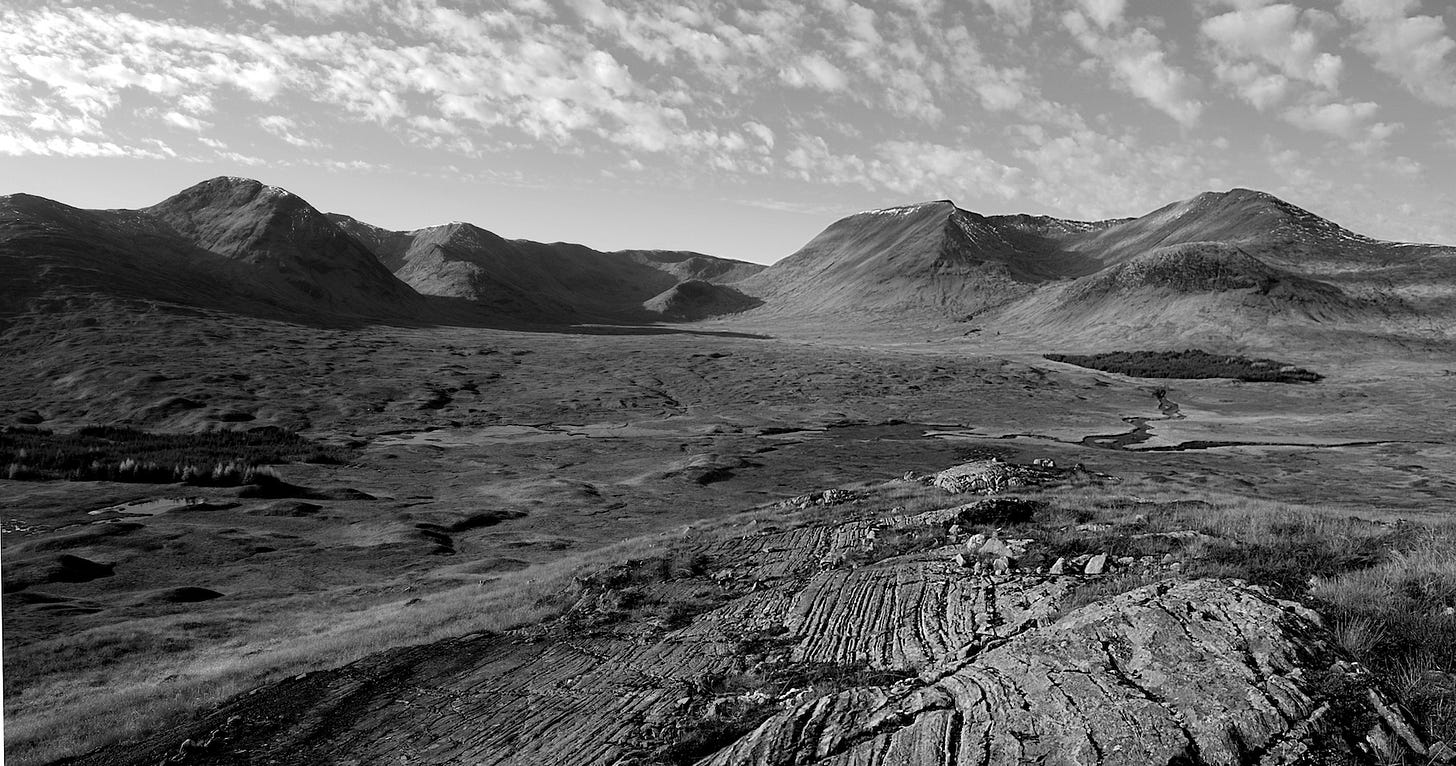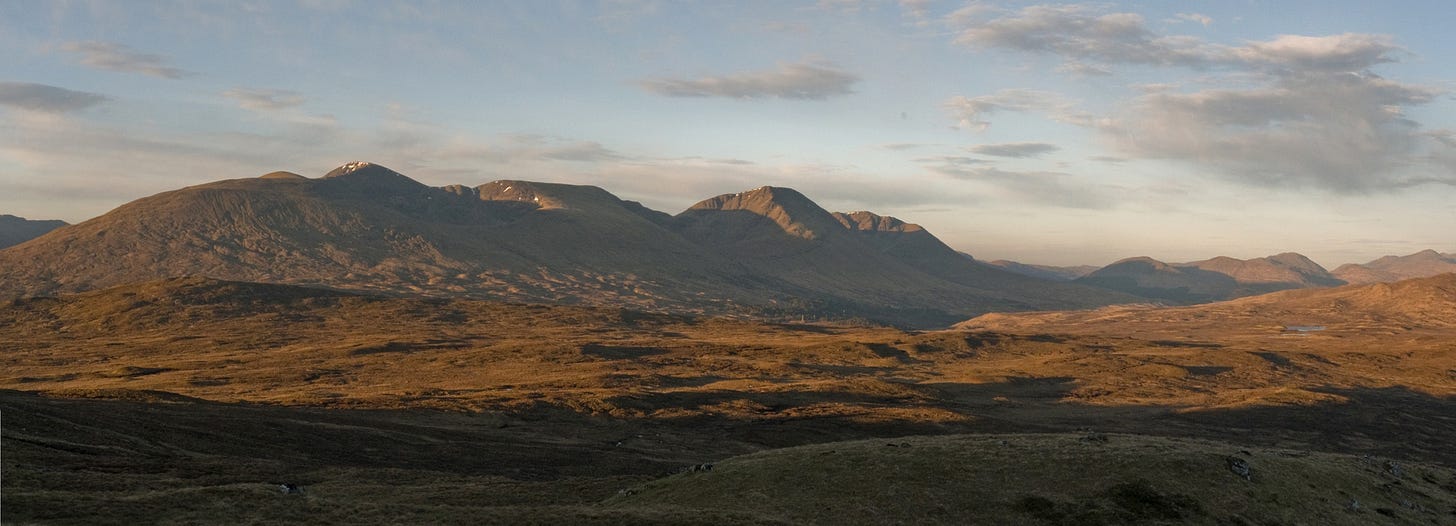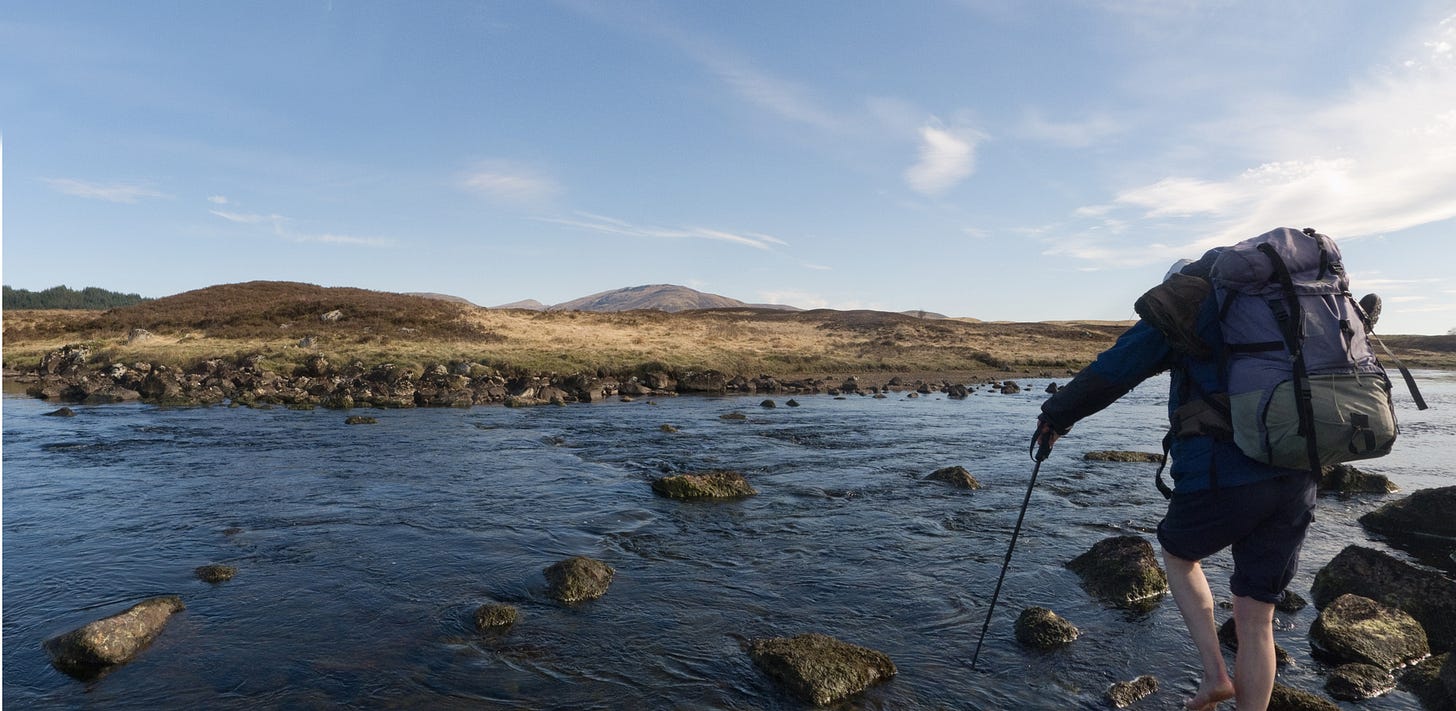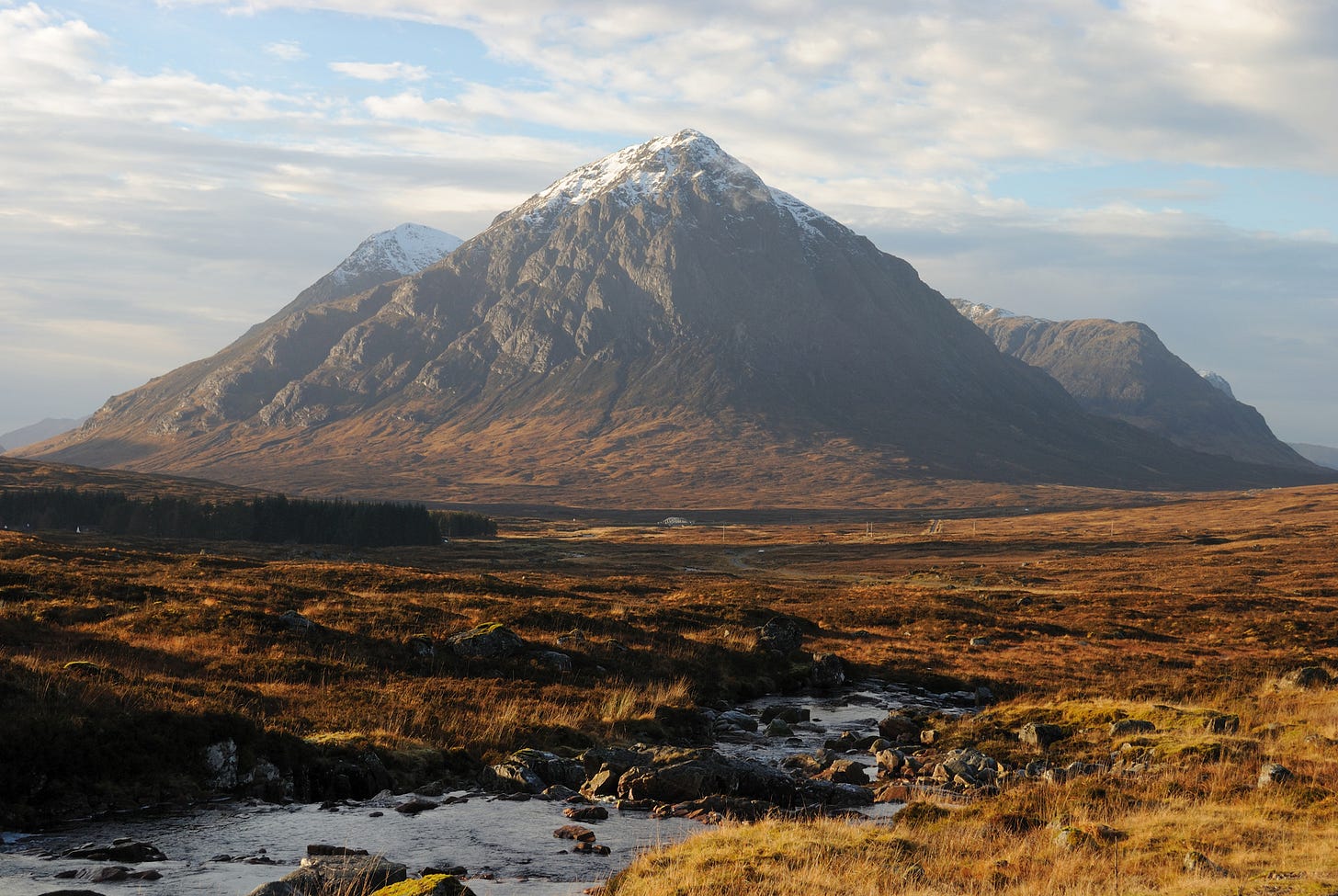A Weight of Beauty
Mountaineer WH Murray crosses Rannoch Moor. And I do too. [1400 words, 7 mins
The famous heat-wave of June 1949 persisted into July. The drought afflicting the whole country became chronic… Conditions for rock-climbing had never been better: I could think of some new routes that I wanted to try. And yet—I thought also of the Moor of Rannoch.
WH Murray ‘Undiscovered Scotland’ 1951
He was impelled into it, it seems, by one of his own slideshows. On his picture of Agag's Wall on Buachaille Etive Mor, with the mountaineer portrayed as 'a fly crawling on the face of a skyscraper', he had pointed out: “This climb commands a magnificent prospect over the Moor of Rannoch.” The assembled mountaineers had greeted this comment with laughter…
I was surprised, the other day, to meet a mountaineer and hillwalker of my own age who went “WH Murray? Who?”
Briefly, then: between the two world wars, Bill Murray was one of the leading Scottish mountaineers: perhaps the greatest of them all in terms of winter climbing on ice and iced-up rocks. Still in the age of nailed boots and step-cutting with the axe, he pioneered the two-handed technique using an adapted slater’s pick: the beginnings of today’s front-pointing technique.
Fighting in the Egyptian desert, he was captured by a German tank commander. In prisoner-of-war camp, he wrote ‘Mountaineering in Scotland’ with a stub of pencil on scraps of toilet paper. When the Gestapo found out and destroyed it, he wrote it all over again. The book became one of the all-time classics of Scottish mountaineering.1
And Rannoch Moor? Rannoch is the hill-free bit in the middle of the Scottish Highlands. Rannoch is 14 miles of peat bog and lochans, and the lonely cry of the curlew. It's the maze of lakes, and the black streams winding between. It's the miles of tussocks and cotton grass between you and the distant West Highland Railway. On crisp autumn days when the sun shines on the mountaintops, cold mist lies all afternoon across the Moor of Rannoch.
Rannoch's where in Stevenson's story ‘Kidnapped’, Davie Balfour and Alan Breck dodged the soldiers through the heat of a summer's day, in the very year 1752 that, in reality, those same redcoats heaved their picks, and wheeled their barrows, and slapped at the midges as they build Major Caulfeild's road towards the Devil's Stair. Rannoch is where seven railway surveyors – including Sir Robert McAlpine himself – wandered a day and a night in a snowstorm.2
Bill Murray planned a double crossing, from the brand-new A82 across to Rannoch Station on the West Highland Railway, then back along the north side of Loch Laidon to Kingshouse . In the heatwave spring of 2018 I followed him across: starting a bit further back, at Thomas Telford’s old road that’s now the West Highland Way, with my bivvy bag for an overnight along the way.
Meall Beag (the smaller hump) and Meall Mor (the larger hump) let me look north across the lochs, lochans and ponds, random as spilled paint and quite uncountable. Islands far enough in to deter a swimming stag are bristly with pine and birch, left over crumbs of the Old Wood of Caledon. Everywhere else is bare: flat greenish-silver water reflecting the hazy summer sky, flat ground whose yellow grasses are not long out from under winter snow. As a landscape it's a splodgework of silver and brown: it's hard to tell if it's ground that's mostly water, or else an inland sea whose islands coalesce.
From beyond the blue a colourless radiance shone, more than usually suggestive of infinite space and of the reality of that infinity. The sparkle of the numberless tarns at noon—the phosphorescent gleam of their night-eyes—the spike of Schiehallion pushing up beyond blue haze at the farther rim, thirty miles away…
I stand back from the slipstream of lorries roaring northwards to Fort William, then step briskly across the A82. My walking poles leave little discs of black peat on the warm tarmac. Dry grass brushes my feet clean on the way up to the line of low humps that will ease me into the heart of Rannoch.
I spend half an hour looking for the prime peatbank: out of the wind, dry at its base, but also with a clear sightline back across the moor. The sky is striped with cloud, but the low sun comes across the lochans, to light up the eastern hill slopes in rusty brown. Luckily, the peat ground is lumpy enough that I say awake for all the late-evening lighting effects.
At sunrise the sky pales to greyish pink behind the jagged skyline of the far-away Mamores. The lochans come alive like a dimmer switch slowly turned up. Straw-coloured sunlight touches the distant hilltops, and picks out the ridges in stripes of black. And then light spilling like runny custard across the moor itself, slurping around every hump and hollow, with the triangle shadow of the hill I’ve been sleeping on stretching right back to where I left Telford’s old road 18 hours before.
And ahead of me, “the waters of the moorland wide enough to add beauty to desolation, both of their kind matchless”.
Across this next stretch Murray, and Heather the Labrador dog, took a line following the south shore of Loch Laidon.
On reaching Loch Laidon I thought the ground improved, although a certain amount of leaping from tuft to tuft was still part of the day's work. On the other hand there were surprisingly few peat-hags. I remember no more than one or two, still exposing the bare bones of the Old Wood…
In heat "as consumingly fierce as the south Syrian desert" (he knew the Syrian desert, he'd been fighting there a few years before) man and dog took frequent dips in the lake as they went along.
I take a more direct line, threading among small lochans and dark, slow streams. The peat underfoot is rising at 1mm every year; has been since the Ice Age. But knobs and knolls of the original glacier-ground ground still emerge, with pale, dead grasses and sparse growth of unhappy heather. Away overhead the skylarks are in full song. Somewhere on the left, a grouse cackles. Somewhere on the right, the morning train to Fort William clanks north across the moor. I don't see deer, but their footprints are everywhere in the bare peat – and where a deer's tiny hooves only sink six inches, my feet can follow.
After four or five hours, the white Moor of Rannoch Hotel appears ahead. With the Garbh Ghaoir river running somewhere through the dip between it and me.
I was worrying about that Garbh Ghaoir river. Bill Murray, dipping into the water all along Loch Laidon, had stopped bothering to put his clothes back on. He crossed the river at his second attempt, wading chin deep with his clothes and his rucksack balanced on his head…
But where the river starts to move again, ready for its drop off the moor’s edge to Loch Rannoch, the canoeists’ website suggests it’s not even worth paddling down unless in a decent state of spate. And down by the railway bridge I waded across it, slightly disappointed and only knee deep, still with all my clothes on.
In the station café they start baking at 7.30am, ready for their lunchtime rush. I wish I could remember all the components of their lumberjack cake. Let's just say that it contains no chunks of leather boot, garish checked shirt or chainsawed-off fingers.
It is a harmony of the vertical and horizontal, simple, serene; its effect on the mind a perfect calm: ideas that in Greek architecture culminated in the Parthenon. [I have] seen its most noble demonstration in the cliffs of the Buachaille Etive Mor, towering over the vast flatness of Rannoch Moor…. Wherever there is a union of the pairs of opposites so perfect that Reason confounded cries: "Two distincts, division none!" there too is an exceeding and eternal weight of beauty.
I inserted ‘one of the’ in an attempt at being a bit balanced. For me, ‘Mountaineering in Scotland’ is the defining book about it all. ‘The Moor of Rannoch’ forms Chapter 17 in the follow-up ‘Undiscovered Scotland’.











Wonderful morning walk, at sunrise, here in the state of Washington, USA. Thank you.
I've done the road, the train, and the West Highland Way, as well as looking down on the Moor from the Buachaille and a few other high points around, but I know I haven't come close to the full experience. Thanks for sharing both Murray's perspective and your own.